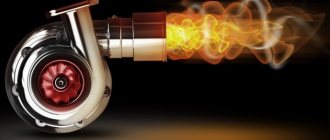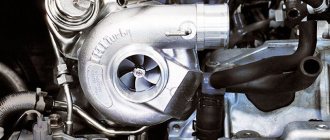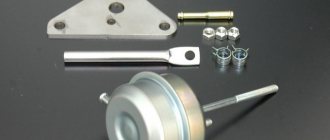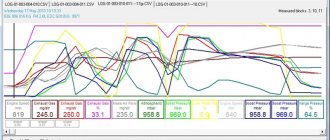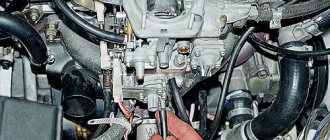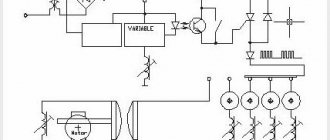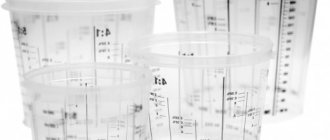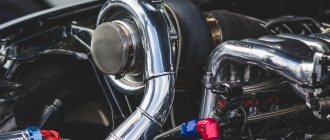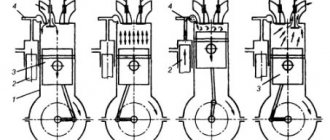Turbine with variable geometry: design and principle of operation.
A conventional turbine consists of 2 impellers connected by an axis. The impellers are located in different chambers. One impeller is rotated by exhaust gases, and the second rotates at the expense of the first, thereby introducing new air into the system.
The general design of a turbine with variable geometry (turbocompressor) impeller and the principle of pumping additional air do not differ from conventional turbocompressors. The main feature is the rotating blades, control mechanism and vacuum drive.
The operating principle of a turbine with variable impeller geometry is based on regulating the flow of exhaust gases directed to the turbine wheel. The adjustment allows you to adjust the flow area for the exhaust gas flow to the engine operating mode.
When driving at low speed, the turbine rotates slowly. However, the control unit sets the petals so that the distance between them is minimal. With a small volume, it is difficult for gas to flow through a small hole, which forces it to move at a higher speed. During overlap, the turbine speed increases, which means the boost pressure increases.
With the help of such petals, you can increase the rotation speed of the turbine without changing the volume of incoming gases. At high speed, the compressor, on the contrary, moves the blades apart. This is designed to maintain safe pressure inside the system and prevent overheating.
The operating principle of variable geometry eliminates the need for a wastegate. The entire flow of exhaust gases passes through the impeller of the “hot” part. Preventing excess boost is achieved by changing the position of the rotating blades.
Changing the distance between the guide elements, depending on the type and model of the turbo engine, is controlled both by the compressor pressure (or lack thereof) and by the vacuum drive, and in some cases by a stepper electric motor
The advantages of this turbine are the following:
- cars with variable turbocharging geometry can produce more power from very low revs.
- reduction of fuel consumption and the amount of harmful emissions into the atmosphere
- due to the absence of a wastegate valve in the “hot” part, the number of multidirectional gas flows is reduced, which improves the passage of gases through the turbine.
- improving engine elasticity
Tuning and adjustment of a variable geometry turbine.
Effective and correct tuning and adjustment of the turbine is important both for the efficiency of its operation, and for reducing the rate of wear of parts of the entire mechanism, and even for saving money on fuel.
This is due to the fact that incorrect operating settings or incorrect (untimely) turbine adjustments directly affect the entire vehicle and the ease of its operation.
While some actions usually mentioned in the instructions for servicing a car and its mechanisms can be taken care of by the owner independently, even without special tools, experience and knowledge - most of them will require the attention of a professional
Every reasonable and caring car owner should remember such principles as: timely prevention and maintenance, as well as avoiding harm through one’s actions. This is true for both gasoline and diesel engines.
Source
Setting up the turbine actuator
The turbine actuator must be adjusted. If this is not done, the entire system will shake while the engine is running. If the adjustment is made incorrectly, the boost will be insufficient. However, incomplete boost may occur if the system's intake has lost its tightness.
Let's start setting up. You can do it in different ways:
- Increase the pressure by replacing the old spring with a more elastic one. If, on the contrary, you need to reduce the pressure, you can install a spring made of mild steel. To lengthen the thrust of the bypass valve, you need to loosen the end of the actuator; to decrease it, on the contrary, tighten it. If the thrust is reduced, the damper will be pressed tighter. Then, to open it, you will have to apply significant force, which means the impeller will spin faster.
- You can increase the boost by installing a boost controller. This mechanism is capable of changing pressure. In order for it to reduce pressure on the wastegate, it must be installed in front of it. The boost controller takes on some of the load as it releases some of the air.
Stem setting
To remove the overblowing, you need to shorten the rod by tightening the adjusting nut (that is, turning it clockwise). Then the blades of the geometry will not open too much. If you need to correct the under-inflating, you need to do the opposite - unscrew the adjusting nut.
How to adjust turbine (turbocharger) geometry
How to adjust turbine (turbocharger) geometry
A breakdown of a turbocharger is not uncommon, because it can be caused by almost any faulty module of a car. In turn, this affects the operation of the engine. Since the main function of a turbine is to regulate pressure and redirect compressed air to the engine, it can become less efficient over time.
This is due to wear (damage) or carbon deposits on the turbocharger blades. Turbine (turbocharger) geometry repair is the adjustment of the turbine and its control system. This is done on special equipment in the service center. To make this adjustment, the compressor must be removed and then reinstalled.
But it is possible to restore the operation of the turbine without removing it. To do this, you need to accelerate the engine speed to 1300 per minute and record the valve duty cycle. It should not exceed 85%. Afterwards you need to tighten the rod legs. To do this, unscrew the screw and slowly rotate the tabs up to +2 revolutions. After work, fix the stop screw.
Turbocharged engine: operating rules
In order for a diesel turbine to operate with maximum efficiency and not fail for as long as possible, you need to adhere to certain rules during the operation of the car:
- adhere to the oil change schedule, which will prevent clogging of the oil line with abrasives;
- use high-quality motor oil that meets the specifications in the engine data sheet;
- do not start immediately after turning on the engine - the engine must be warmed up;
- immediately after stopping movement, do not turn off the engine, allowing it to idle for at least 10 seconds.
Design and principle of operation of a turbine with variable geometry
A turbocharger is used to increase engine power, which is directly dependent on the volume of air and fuel supplied to the cylinder. The leading parts of any turbocharger are the turbine and the pump, which are connected to each other by a rigid axis. An engine turbine with variable geometry is necessary to generate optimal engine power; it has the property of changing the cross-section of the turbine wheels depending on the total load. If the engine is running at low speeds, the turbine can increase the speed at which exhaust gases are removed. This allows the turbine to spin faster while keeping the amount of fuel small.
How the turbine works and how it works
A turbine with modified geometry differs from classic turbochargers in that it has a ring and special blades with an aerodynamic shape in its design, which helps to increase the efficiency of charging. In cars with small engines, the cross section is adjusted by changing the orientation of these blades. In high-power engines, the blades do not rotate, but are covered with a special casing or moved along the axis of the chamber.
The VNT turbine features rotating blades, a control mechanism and a vacuum drive. The operating principle is based on adjusting the flow of exhaust gases, which are directed to the turbine wheel. Precise adjustment allows you to adjust the flow area for gas flow to the engine operating mode. If the car moves at low speed, then the turbine rotates more slowly, but at the same time the petals are set in such a position that the distance between them is minimal. It is difficult for gas in a small volume to overcome a small hole, so it will move at a higher speed, due to which the turbine speed increases, thereby increasing the boost pressure.
Using these blades, you can significantly increase the rotation speed of the turbine without changing the volume of incoming gases. At high speed, the compressor moves the blades apart - this ensures that a safe pressure is maintained inside the system and eliminates overheating. The principle of variable geometry makes it possible not to use a bypass valve, since the entire volume of exhaust gases exits through the hot part of the impeller. Changing the position of the rotary valves prevents over-boost.
How to extend the service life of a product
Using simple rules, you can seriously extend the life of both individual elements of the turbocharger (including the vacuum regulator) and the entire device as a whole. The following describes the operational features in different engine operating modes:
- Start the engine. When starting, try to use gas to a minimum, and keep the engine at idle speed for at least a minute. The fact is that in a turbocharged compressor the necessary parameters are established within a few seconds if good lubrication is supplied. If you turn on the gas at the very beginning of the power plant start-up, the impeller will be forced to spin in conditions of insufficient oil supply, which will lead to its breakdown.
- Start in winter. If the engine has not been running for a long time or you have to start the engine at sub-zero temperatures, start only at idle speed so that the oil fills the turbocharger.
- Stopping the engine. Before the ignition is turned off, let the power plant run for a while on XO. Otherwise, temperature changes will occur in the turbocharger, and oil will abruptly stop supplying the components of the device, which will still spin by inertia.
- Idle speed. It is not recommended to keep them for more than half an hour. If this time interval is exceeded, the impeller will rotate at insufficient speed, which risks the penetration of oil vapors through the connections. As a result, a bluish exhaust appears from the muffler.
- Actions before starting the engine for the first time after a major overhaul. First make sure the turbocharger lubrication system is full. Next, without starting the engine, turn the crankshaft so that the oil begins to circulate. Start the engine and let it idle for ten minutes.
Compliance with these recommendations will extend the life of the turbocharger and avoid premature adjustment, or even costly repairs.
Source
How to set up and adjust a turbine
Proper adjustment of the variable geometry turbine is essential for efficient operation, and in order to prevent rapid wear of parts and reduce fuel consumption. If the turbine is adjusted incorrectly, this will subsequently affect the operation of the entire vehicle and the ease of its control.
Any modern car owner knows a little about the structure of his car and can even fix certain minor breakdowns. However, to make serious car repairs, you need special tools and equipment that the average consumer may not have.
Therefore, if you want the operation of the turbine to be efficient and of high quality, seek help from specialists who will correctly set up the mechanism and tell you how best to care for it. Also, do not forget about timely diagnosis and prevention.
How to clean a turbine with your own hands
The turbine device constantly faces continuous load, is exposed to the combustion products of oil and fuel, and therefore requires regular cleaning to prevent various breakdowns that may be associated with this. Often, it is enough to treat the turbine with a special agent and run it through the mechanism for high-quality cleaning. However, sometimes you will have to put in more effort to remove all dirt from the device. It is also worth remembering that the turbine does not require frequent cleaning, so if it becomes very dirty in a short time, it means there is a problem with its operation or settings.
The causes of severe pollution can be:
- Increase in gas pressure.
- Wear of turbine blades.
- Exceeding the required service life of the piston compartment.
- Breather clogged.
- Wear of gaskets.
That is why every car owner should understand that it is possible to do high-quality cleaning on their own, but the result of such actions does not always have a positive effect on the operation of the mechanism, and in some cases it can even worsen the situation.
Lack of proper experience, proven cleaning products, special tools - all this can negatively affect the result of your cleaning, so it is best to contact specialized centers where professionals do this work.
How to repair a turbine?
It is much easier to prevent turbine repairs through regular maintenance and diagnostics than to try to correct the situation yourself later. The process is further complicated by the fact that many car owners are afraid of high prices for professional services, forgetting that carrying out repairs on their own also takes a lot of money and time. In addition, not everything works out the first time, and the costs of DIY repairs can be quite impressive.
Wastegate replacement
Its full repair is possible only in a specialized technical center, where the device can be most accurately diagnosed. Causes of vacuum regulator failure:
- termination of the functioning of the electronic unit responsible for opening/closing the valve;
- drive gear failure;
- failure of the electric motor that ensures proper operation of the shutters.
If it turns out that repairing the vacuum regulator will be quite expensive, then it is advisable to replace the turbine actuator with a new part. The process is carried out as follows:
- Remove the old cuff.
- Clean and degrease the seat and the new part with acetone.
- Using adhesive sealant, install a new cuff.
- There are caps on the body and there must be a gap between them to allow for additional lubrication.
- Glue the membrane with the same product and roll it in a circle.
The difficulty of repairing the most modern models of actuators lies in the presence of complex electronic components, the breakdown of which leads to failure of the servo drive. You can’t do without professional equipment here. This could be, for example, a Turboclinic tester. It allows you to diagnose and adjust electronic components of systems such as Toyota, Garret, MHI, IHI.
Turbine with variable geometry: how to get around the disadvantages?
The turbocharger in a diesel engine is a central element for comfortable and dynamic driving. Thanks to the turbine, cars even with a small engine capacity become real supercars, significantly increasing their power.
But turbo technology has one drawback, which drivers call “turbo lag.” It manifests itself in a decrease in engine power at low speeds. Since the turbocharger accelerates the exhaust gases, at low speeds they become insufficient to reach the optimal operating speed.
Disadvantages of using a turbocharger
It would seem that installing a turbodiesel entails continuous advantages, but this is not so. The device has certain disadvantages:
- fuel consumption increases, which is especially noticeable if the system is not adjusted correctly;
- the temperature rises during compression, which can lead to detonation. To avoid such a nuisance, it is necessary to install regulators, coolers and a number of other elements.
The operating principle of a variable geometry turbine and its advantages
The turbojam can be removed by installing a unit with a smaller flow section. But at high speeds this will become a barrier to incoming air and will only limit engine power.
According to Turbomicron specialists, the variable geometry option combines the advantages of a small section unit at low speeds and a large turbocharger at high speeds. The system works like this:
- special adjustable blades are installed around the impeller, which is accelerated by exhaust gases;
- at the moment of insufficient gas pressure, the blades change the geometry of the flow, accelerating it and increasing the performance of the turbocharger;
- When power is gained, the vacuum valve smoothly regulates the opening geometry of the channel, ensuring optimal engine operating conditions at any time.
This operating principle makes it possible to bypass all the disadvantages of standard turbines without significantly changing the engine design:
-
(turbojam) in traction at low speeds disappears - fuel consumption is reduced
due to more complete combustion; -
of the exhaust gases and the engine decreases - The engine life is increased
by increasing the efficiency of its operation.
Turbine breakdowns and their diagnosis
But this design is not without its drawbacks. Added to the popular “diseases” of turbochargers is the formation of soot, which interferes with the normal functioning of the blades. Difficult or incomplete closing/opening of the blades leads to two negative consequences:
- overblowing
- when the blades are not thrown back at high speeds, excess pressure is created in the air supply system. As a result of such a malfunction, the fuel mixture becomes leaner and the exhaust valves even explode. The engine stalls and refuses to operate at high speeds; - under
-inflating is the reverse side of the previous problem, in which turbo lag clearly manifests itself.
Restoring turbine geometry
The Turbomicron company said that repair of turbines with geometry failures is carried out only by mechanical cleaning and eliminating the cause of interruptions in the system, since in addition to clogging of the blades with soot, the cause of poor geometry operation may be a worn actuator valve.
Of course, it is better to entrust the work of restoring the unit to professionals. In addition to quickly identifying the problem and providing a high-quality solution, they will correctly adjust the geometry on a special stand. Doing this at home is not only difficult, but also fraught with additional problems. Plus, specialists will guarantee their work from 1 to 3 years. It's convenient and reliable.
Source
